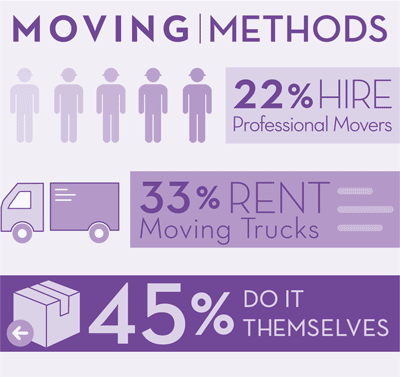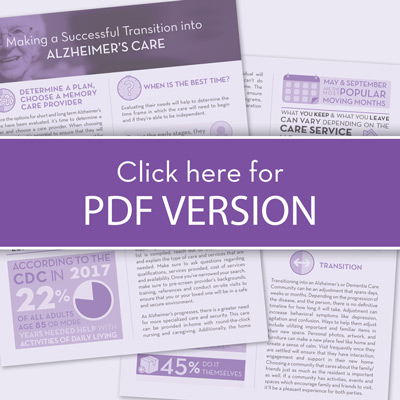Making a Successful Transition into Alzheimer’s Care
Determine a Plan, Choose a Memory Care Provider
Once the options for short and long term Alzheimer’s care have been evaluated, it’s time to determine a plan and choose a care provider. When choosing your provider, it’s essential to ensure that they will meet basic needs and provide a safe environment for you or your loved one.
To begin assessing care needs, identify where assistance is needed and if the person is able to perform Activities of Daily Living. Activities of Daily Living or “ADLs” include eating, bathing, getting dressed, toileting, and transferring. The performance of these ADLs is important in determining what type of long-term care is best. Also consider medication management when making this decision.
22% of all adults aged 85+
needed help with activities of daily living.
When is the best time?
Evaluating their needs will help to determine the time frame in which the care will need to begin and if they’re able to be independent.
-
 During the early stages, they may still live independently
During the early stages, they may still live independently -
 In the middle stages, 24-hour supervision will be required
In the middle stages, 24-hour supervision will be required -
 In the late stages, they will need specialized round-the-clock care
In the late stages, they will need specialized round-the-clock care
Once you’ve determined what type of care is needed, contact providers who will be able to assist you. Resources to find specialized care providers include your local Alzheimer’s Association, doctors, support groups and trusted referrals. Once your list is compiled, reach out to them individually and explain the type of care and services that are needed. Make sure to ask questions regarding qualifications, services provided, cost of services and availability. Once you’ve narrowed your search, make sure to pre-screen provider’s backgrounds, training, references and conduct on-site visits to ensure that you or your loved one will be in a safe and secure environment.
As Alzheimer’s progresses, there is a greater need for more specialized care and security. This care can be provided in-home with round-the-clock nursing and caregiving. Additionally, the home will need to be secure and the individual will need to be monitored so they cannot do anything to harm themselves or the home. The move to a memory care community certifies that healthcare services, memory care programs, home maintenance/ cleaning, food preparation and security are specialized.
What to Keep, What to Leave
Ensuring a plan is in place and a move is made when the person is still healthy ensures that making the move is their choice and on their terms. They’re able to properly say goodbye to a home they’ve lived in for years and choose which items come with them, it’s an important part of the transition. The person is able to gradually downsize the things that they have, it’ll be less traumatic and they’re able to preserve memories, keepsakes and important items. If a move has to be made quickly from home-care to more residential care, the home and all of the belongings inside can become the overwhelming responsibility of the children, friends, and family. Going through an accumulation of belongings one had collected in their lifetime can be a painstaking task where things of value can be thrown into the garbage. Adult children and family members should carefully consider how much time, energy, and emotion that they can dedicate to a downsizing project without being burned out.
When sorting through belongings, think about where you or your loved one will be moving to, what services will be provided, and what other amenities are available there. Possibilities to consider include maintenance free living, if an automobile is needed, cleaning services, cooking services and meals, climate, appliances, amount of furniture in the space.
Choosing a long-term care community where all levels of care (Independent Living, Assisted Living, Memory Care, Skilled Nursing, and Senior Rehabilitation) are available as progression continues, allows you to move into a community and not have to move again.


Transition
Transitioning into an Alzheimer’s or Dementia Care Community can be an adjustment that spans days, weeks or months. Depending on the progression of the disease, and the person, there is no definitive timeline for how long it will take. Adjustment can increase behavioral symptoms like depression, agitation and confusion. Ways to help them adjust include utilizing important and familiar items in their new space. Personal photos, artwork, and furniture can make a new place feel like home and create a sense of calm. Visiting frequently once they are settled will ensure that they have interaction, engagement and support in their new home. Choosing a community that cares about the family/friends just as much as the resident is important as well. If a community has activities, events, and spaces which encourage family and friends to visit, it’ll be a pleasant experience for both parties.
To learn more about dementia care, check out our blog series covering everything from Identifying Alzheimer’s to Making a Successful Transition into Memory Care.



